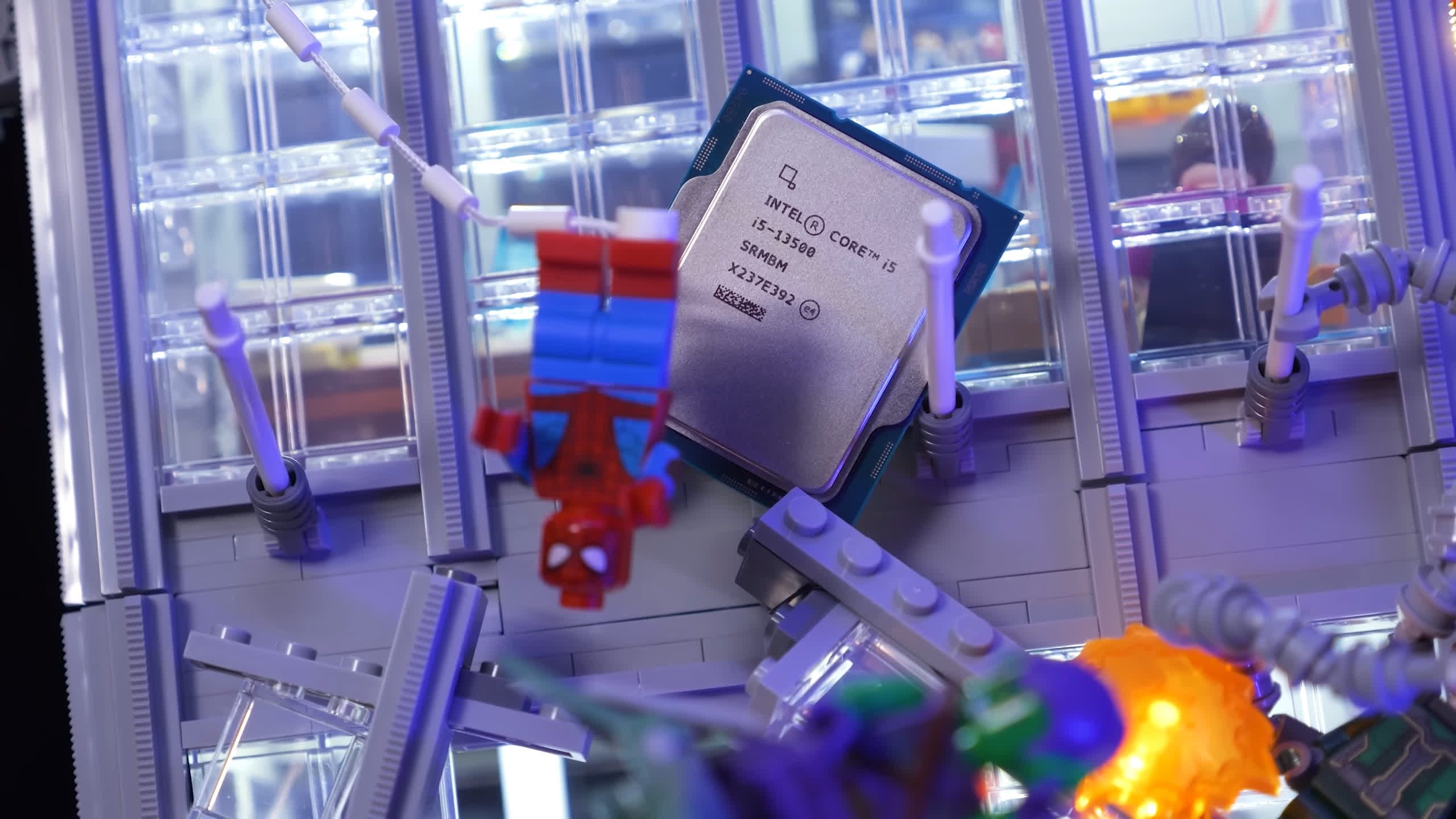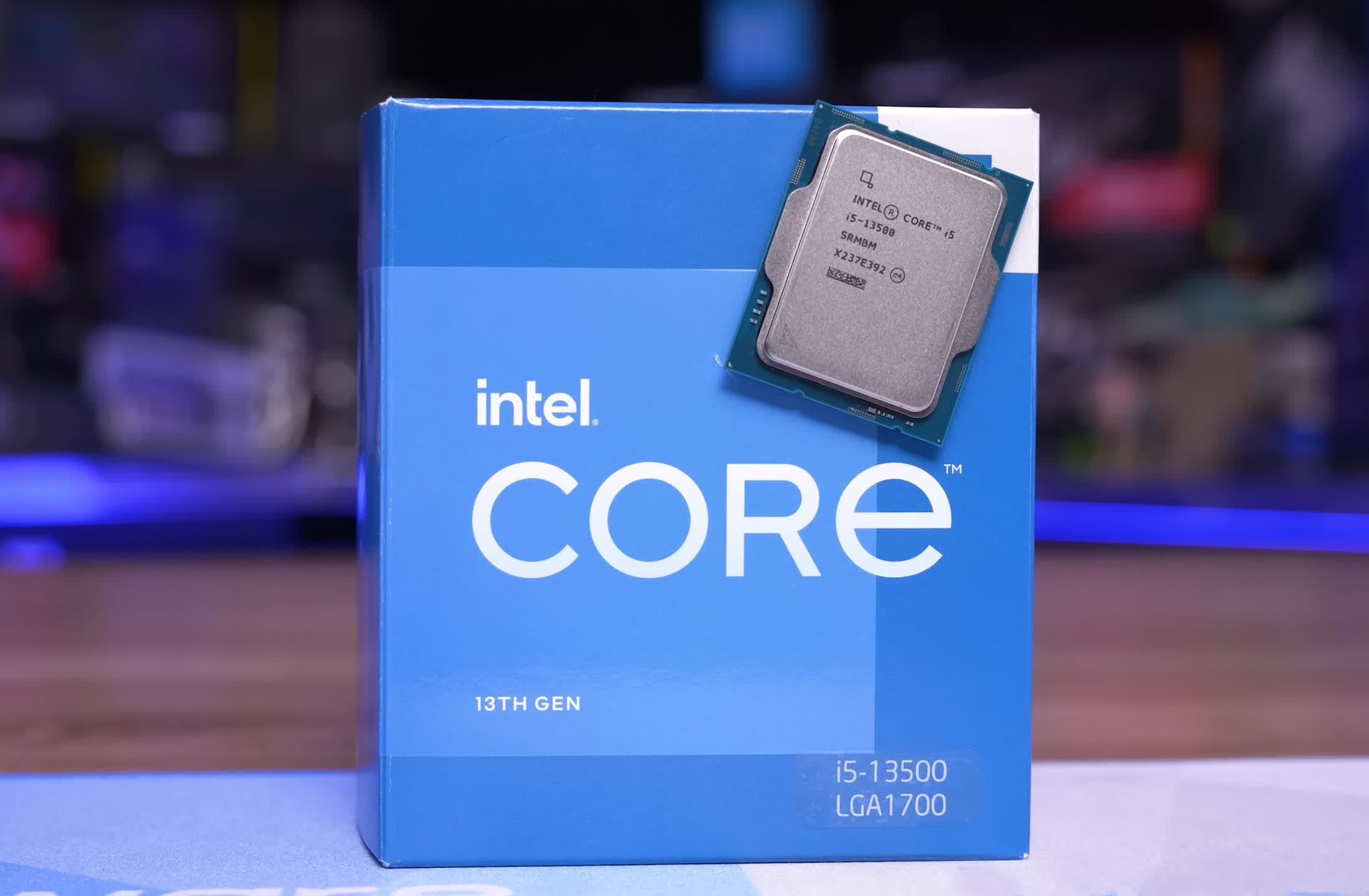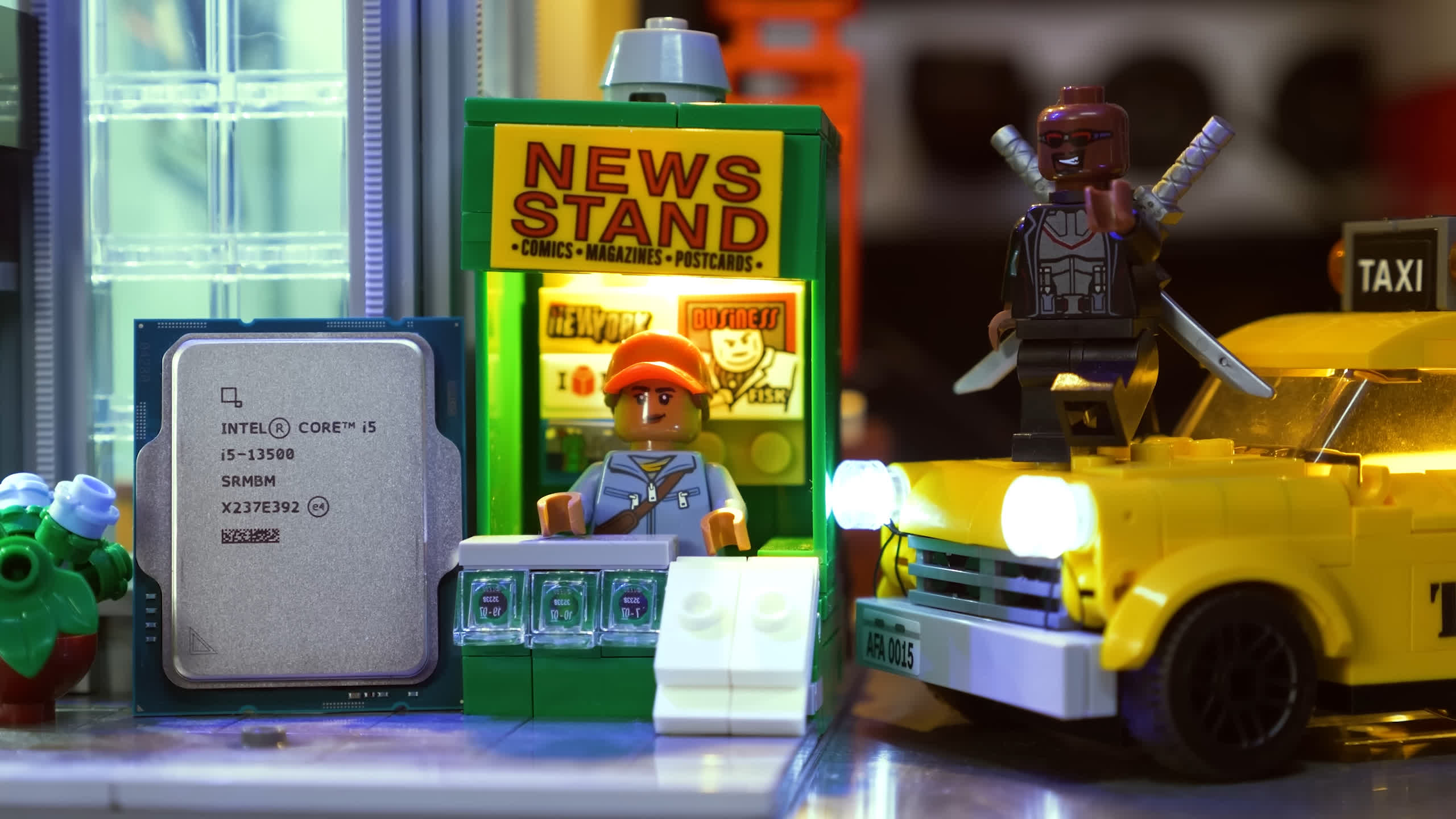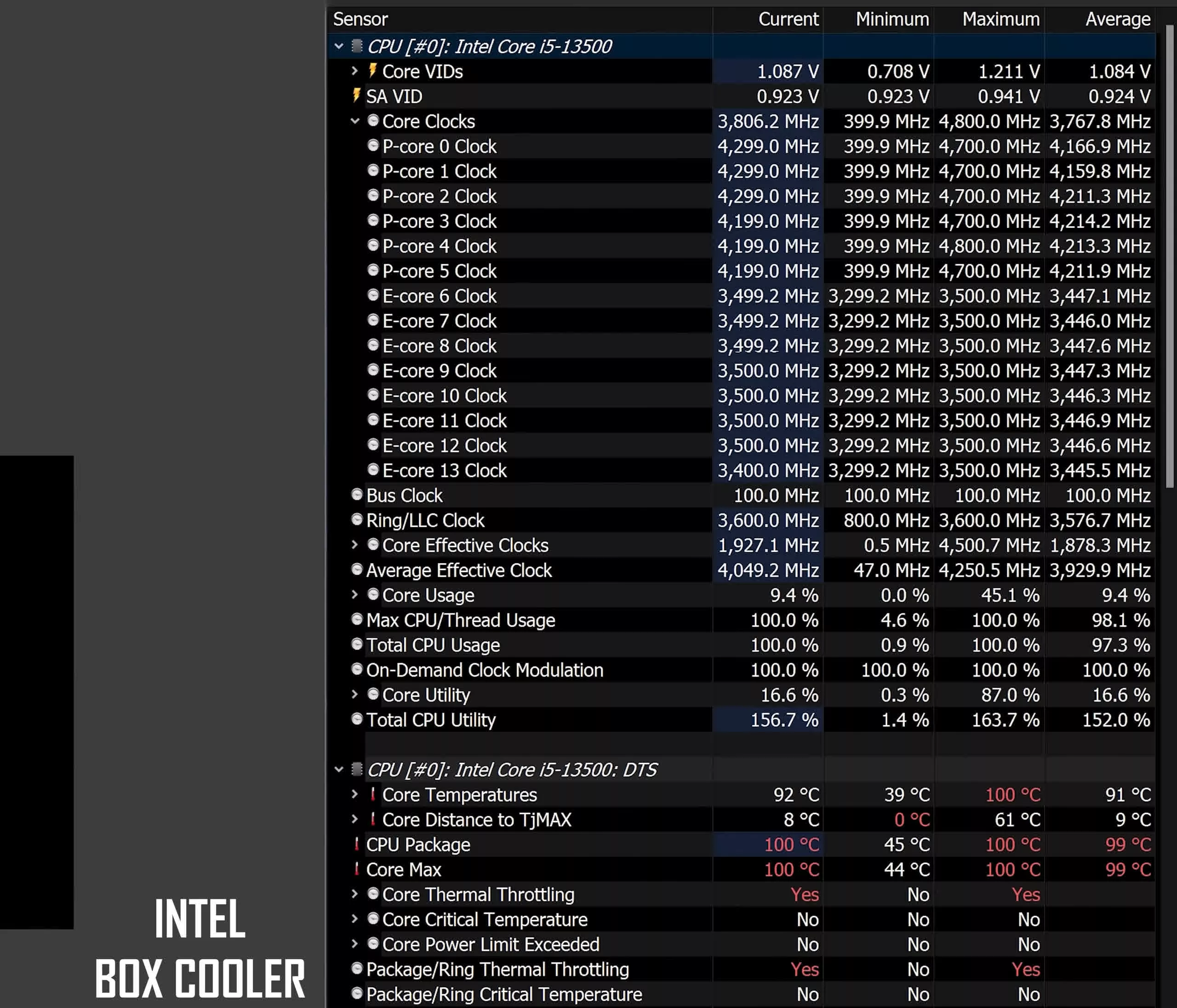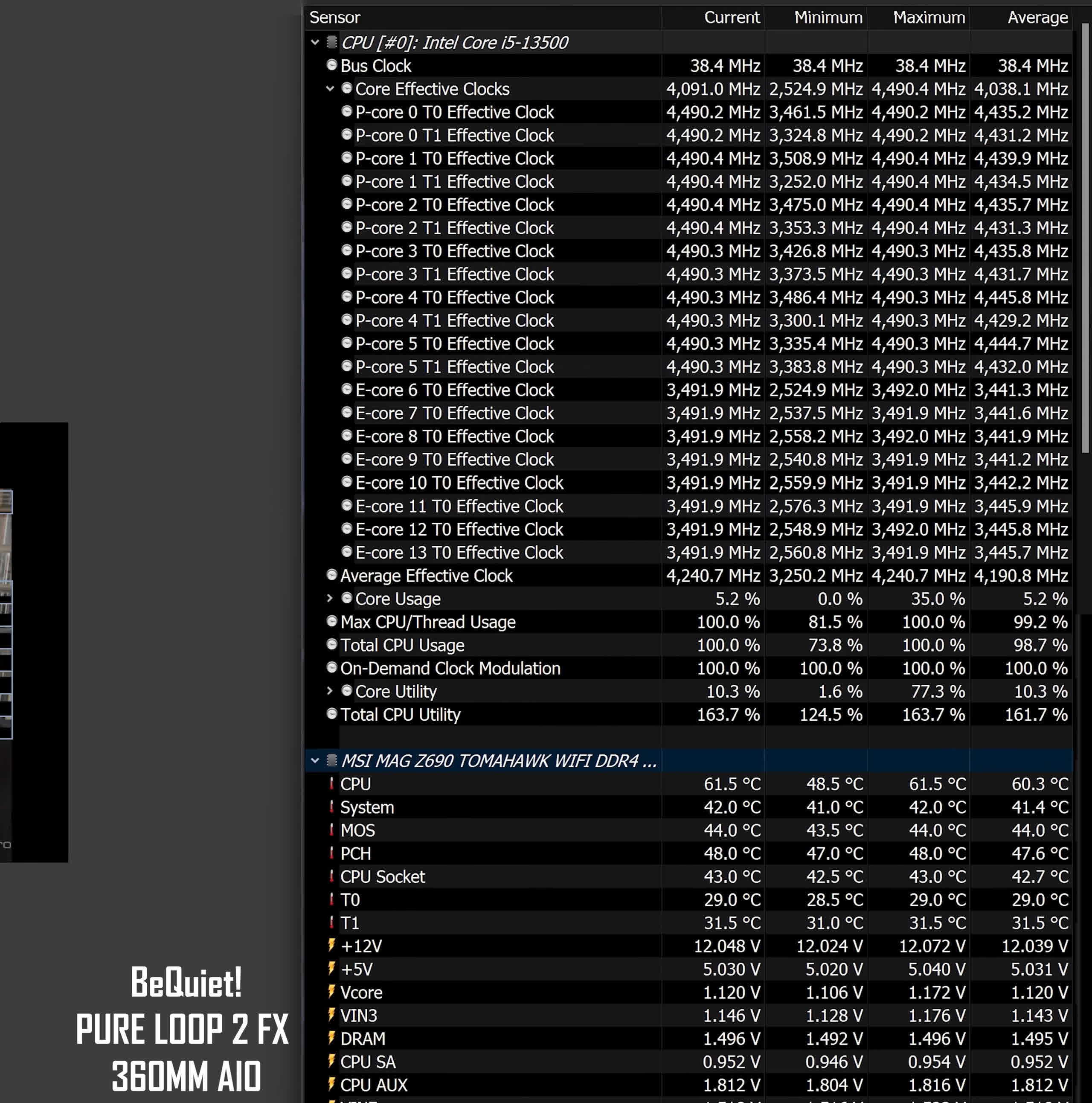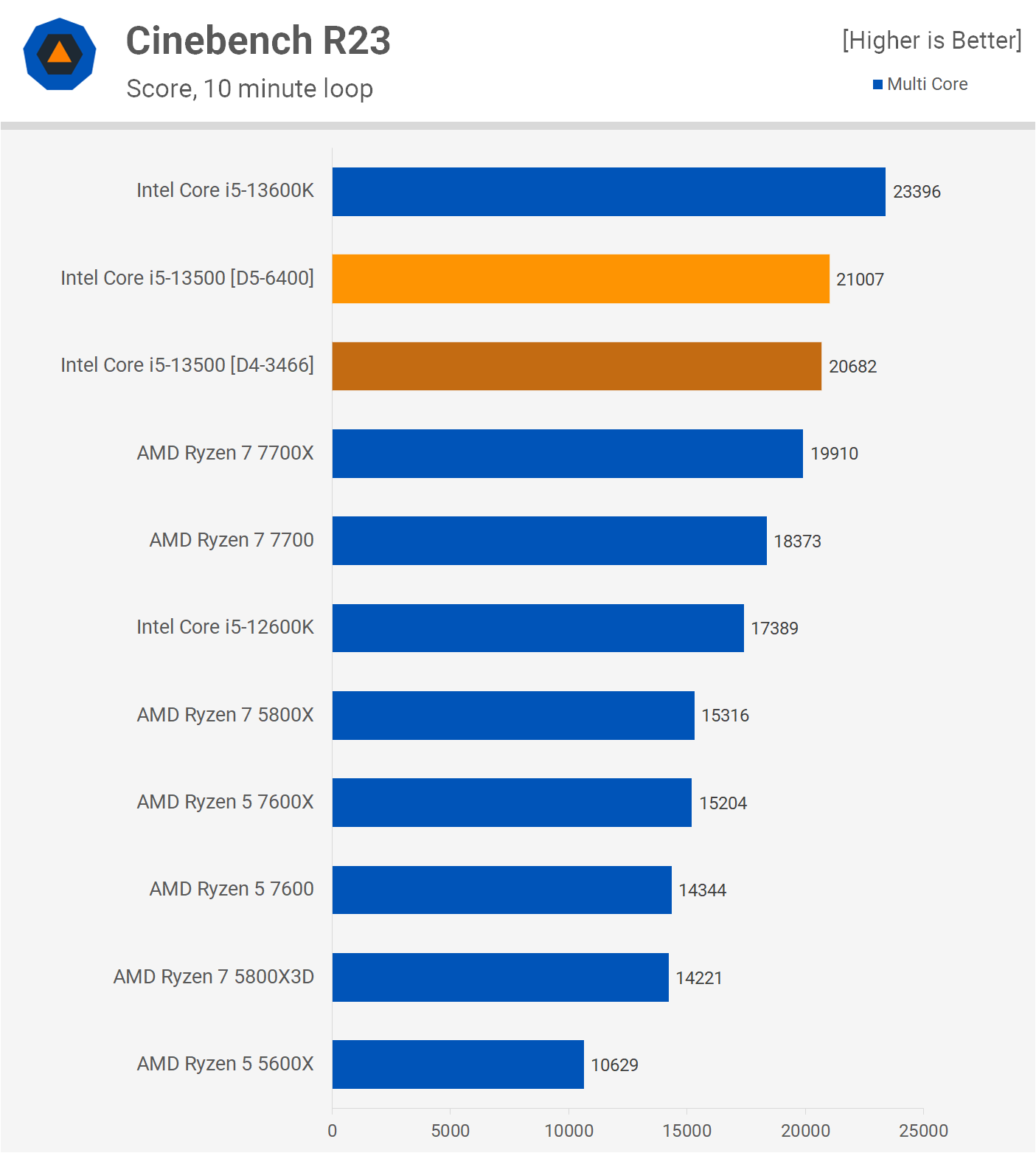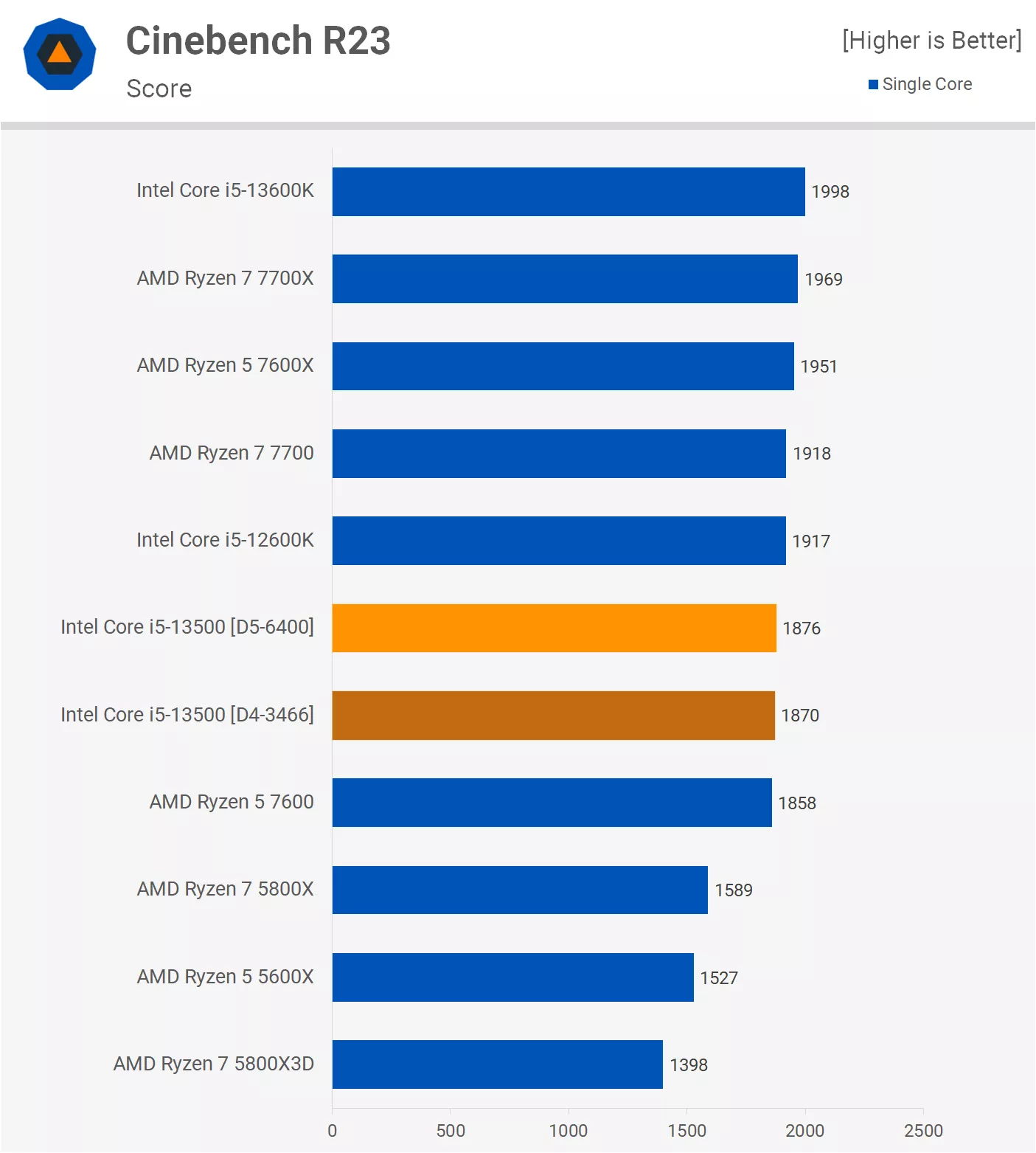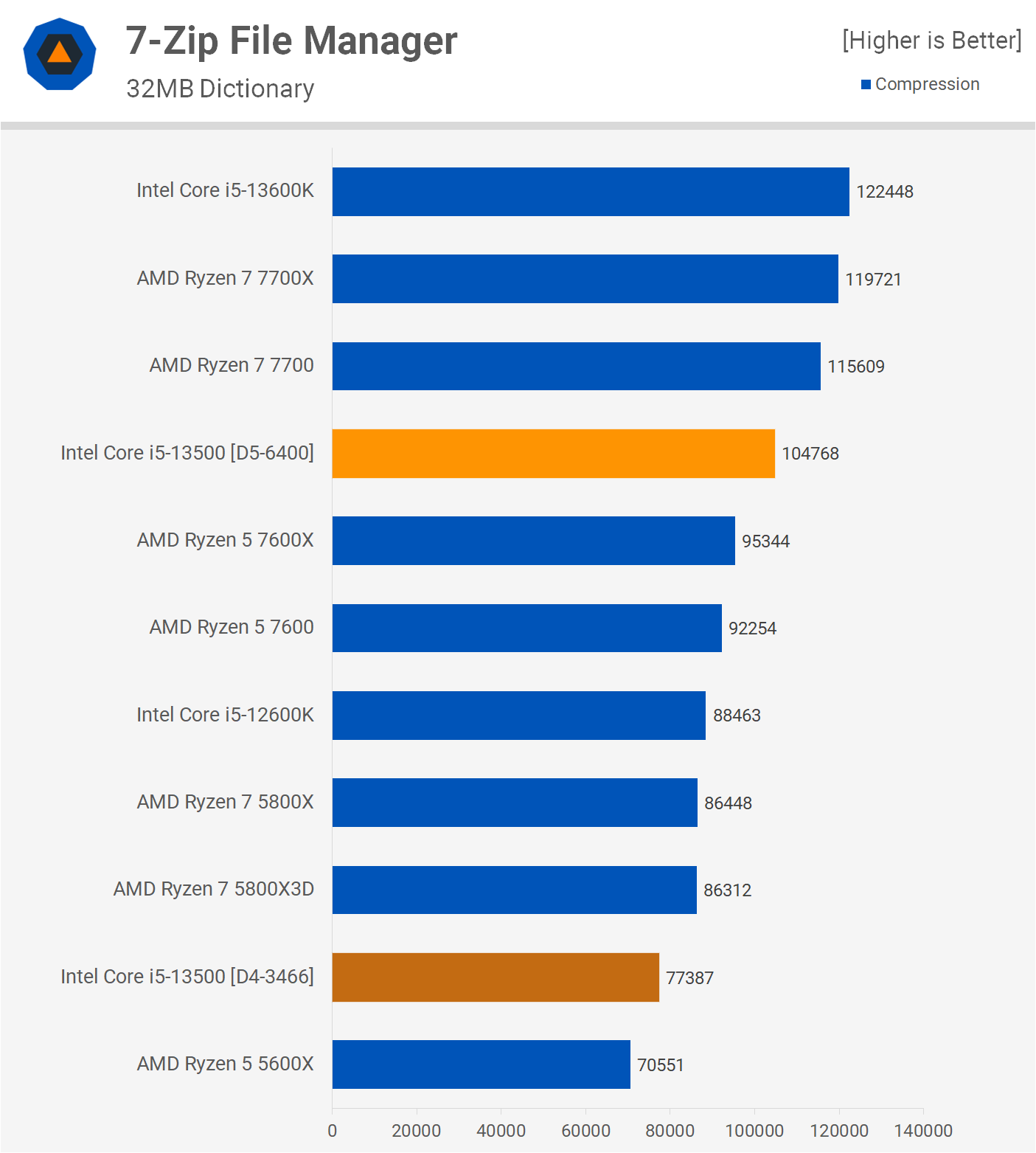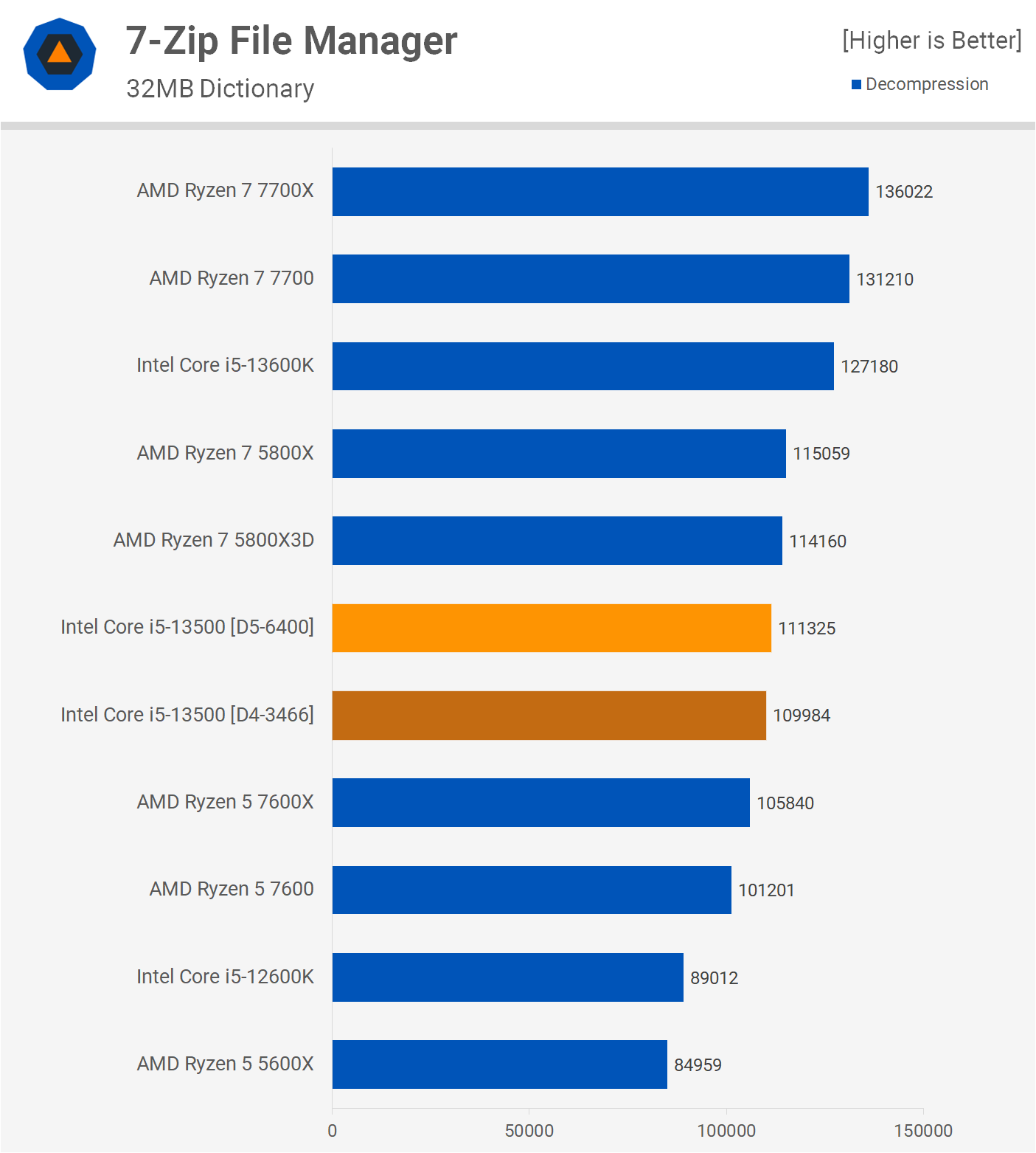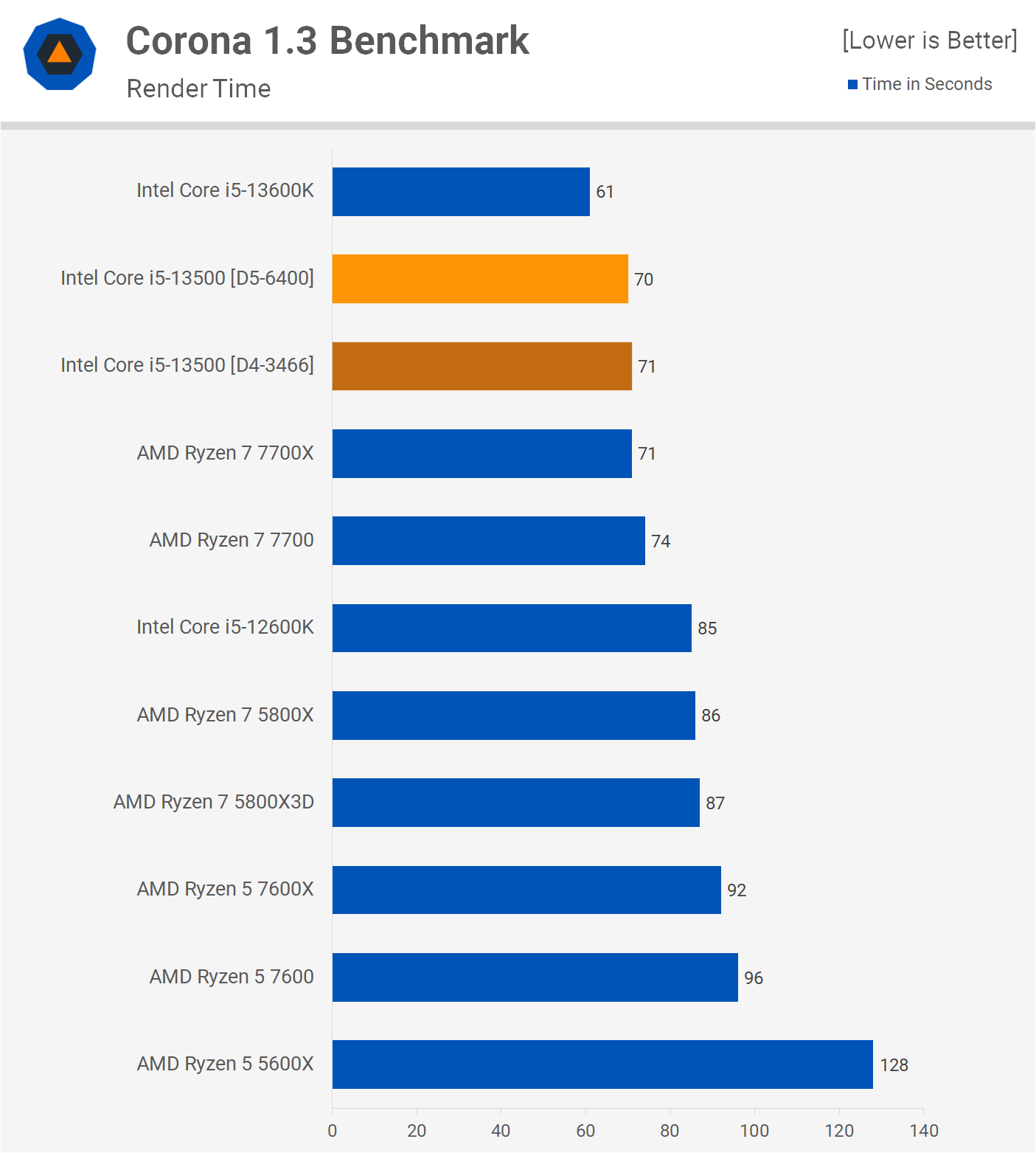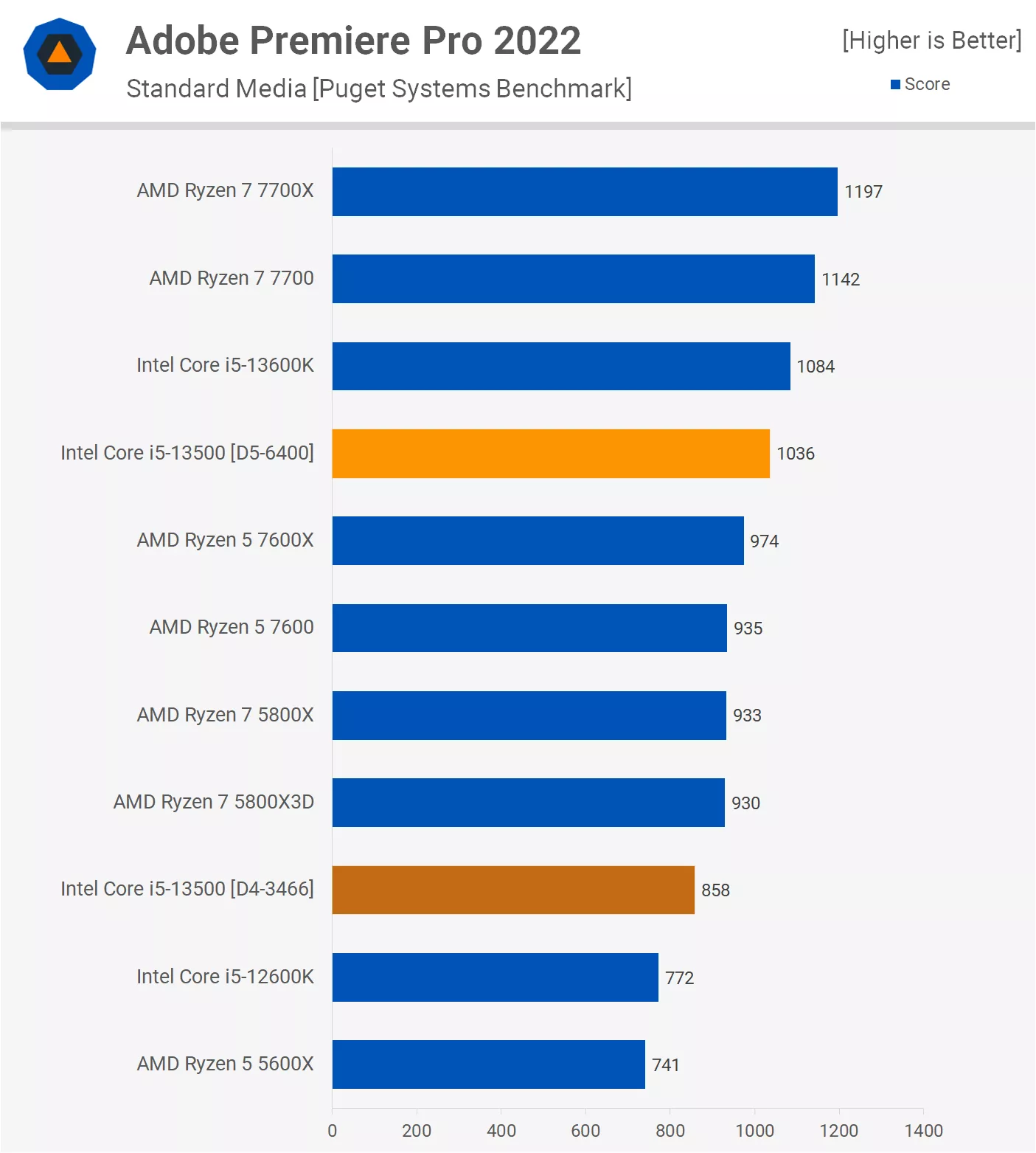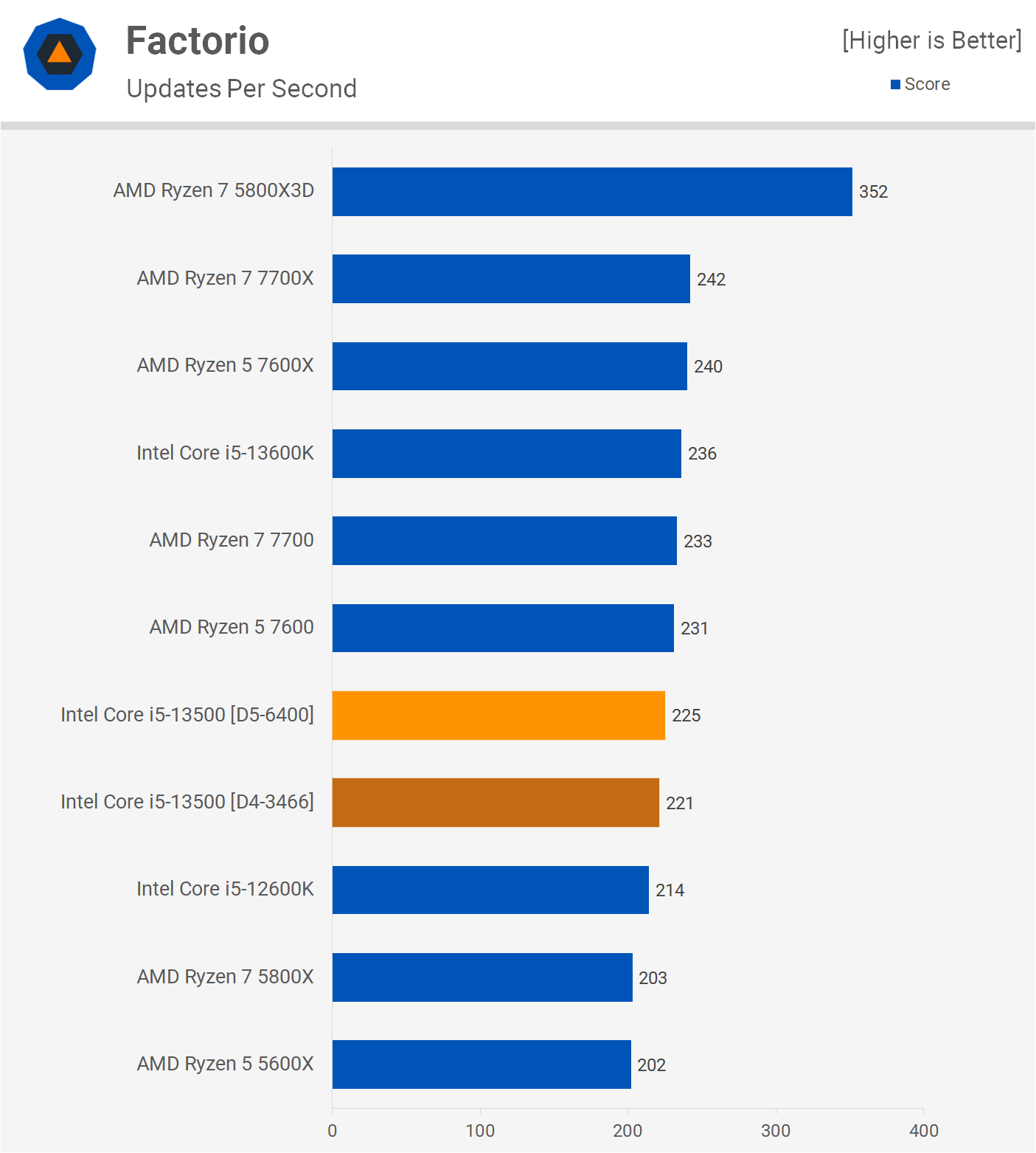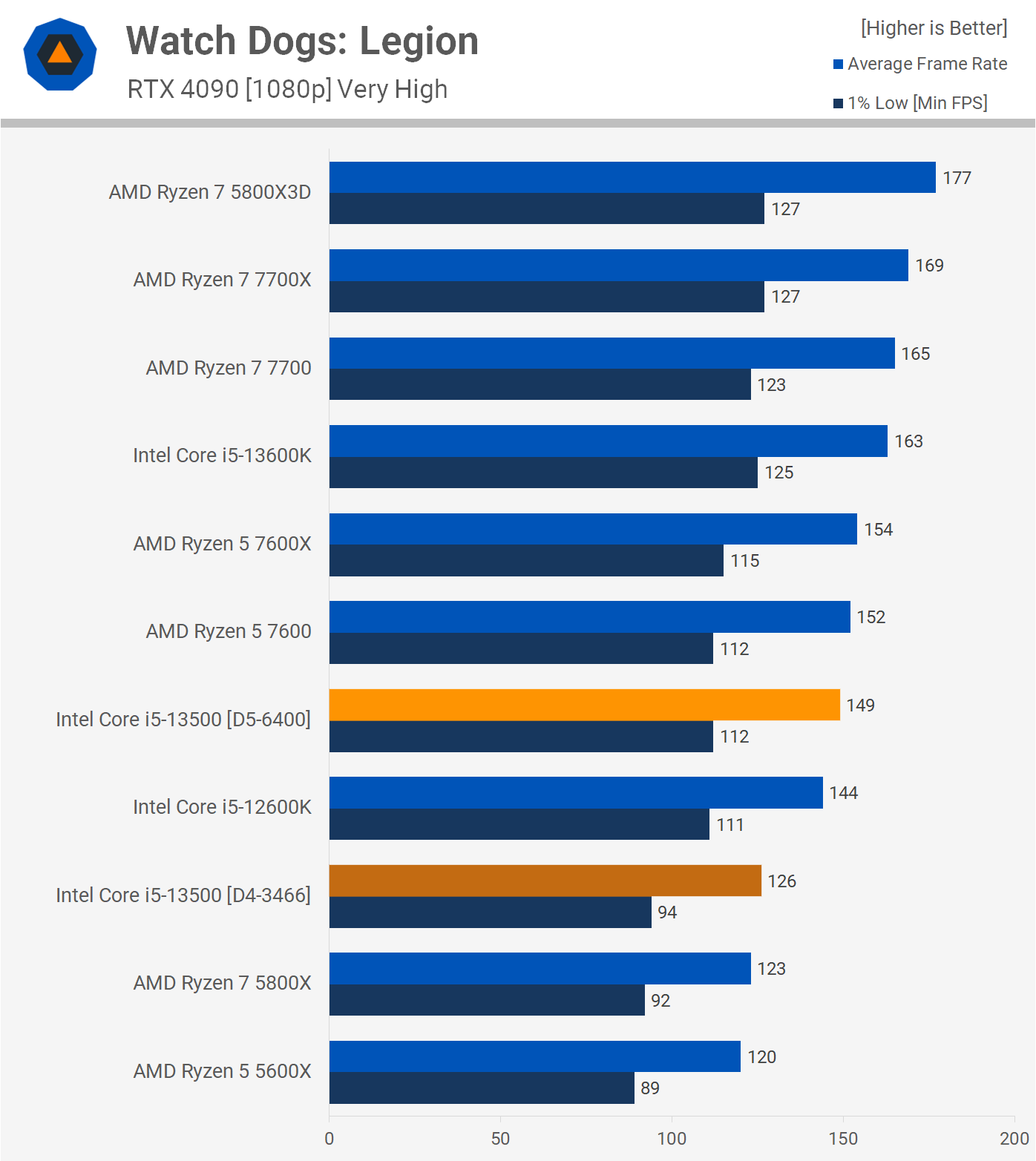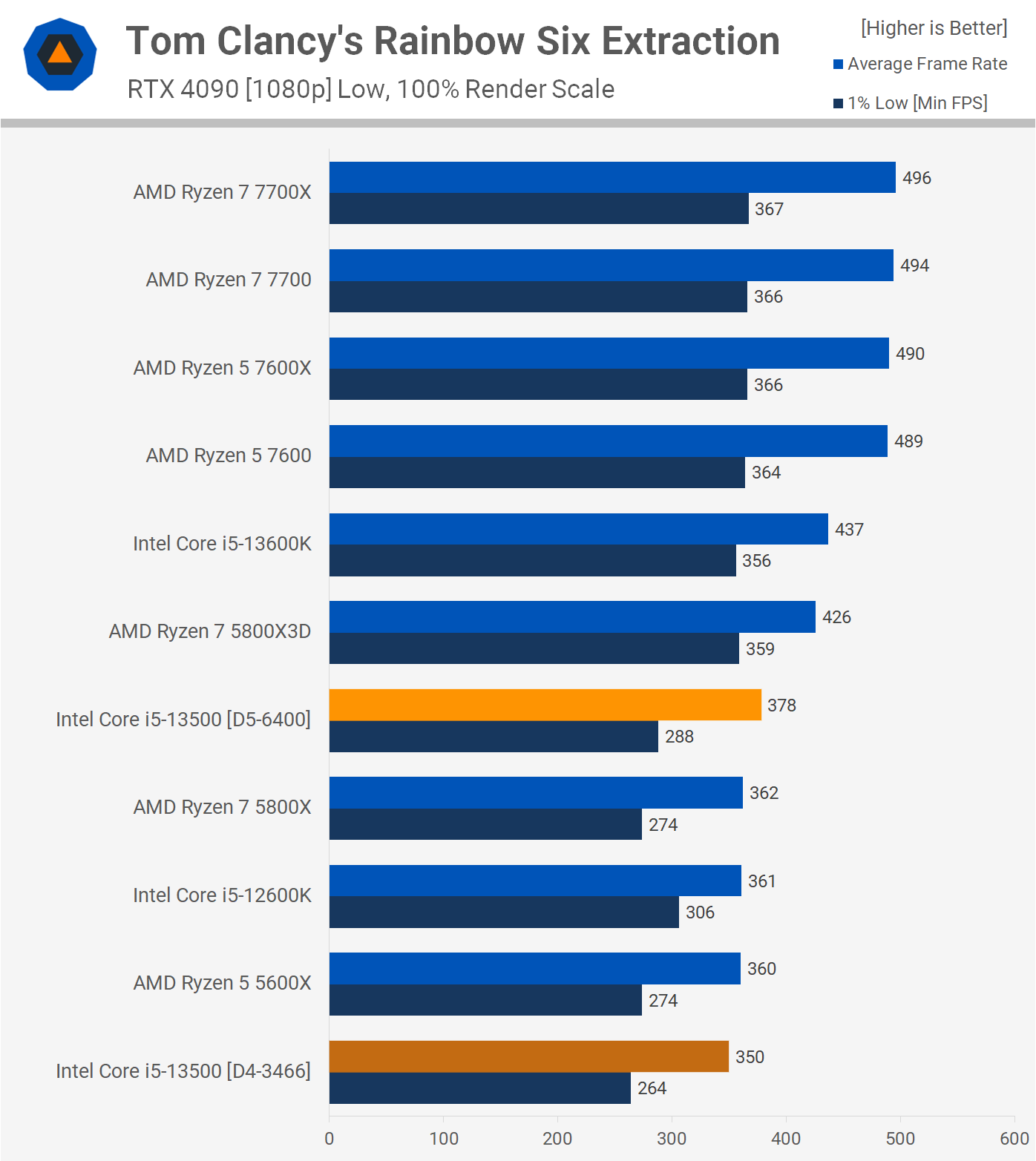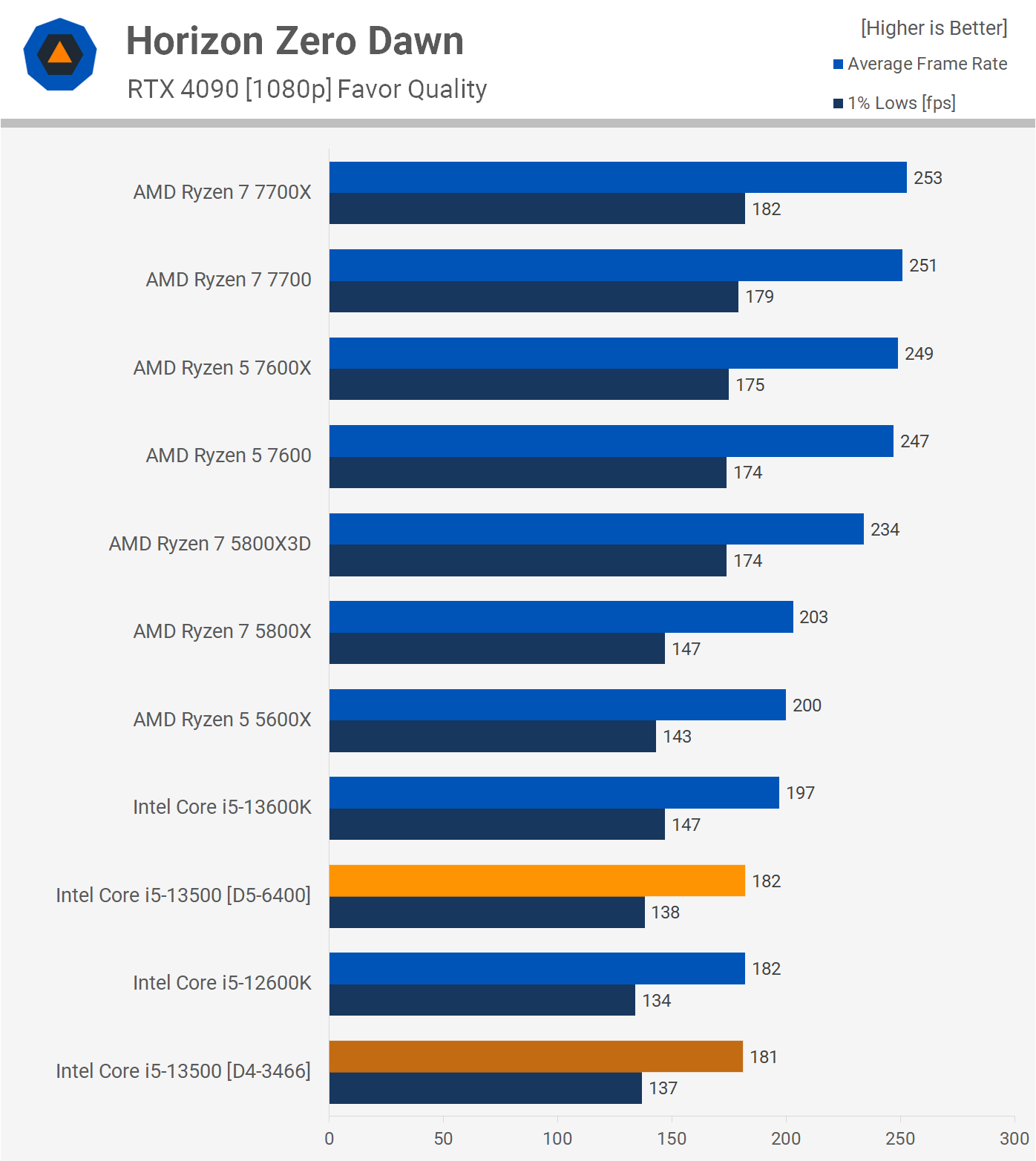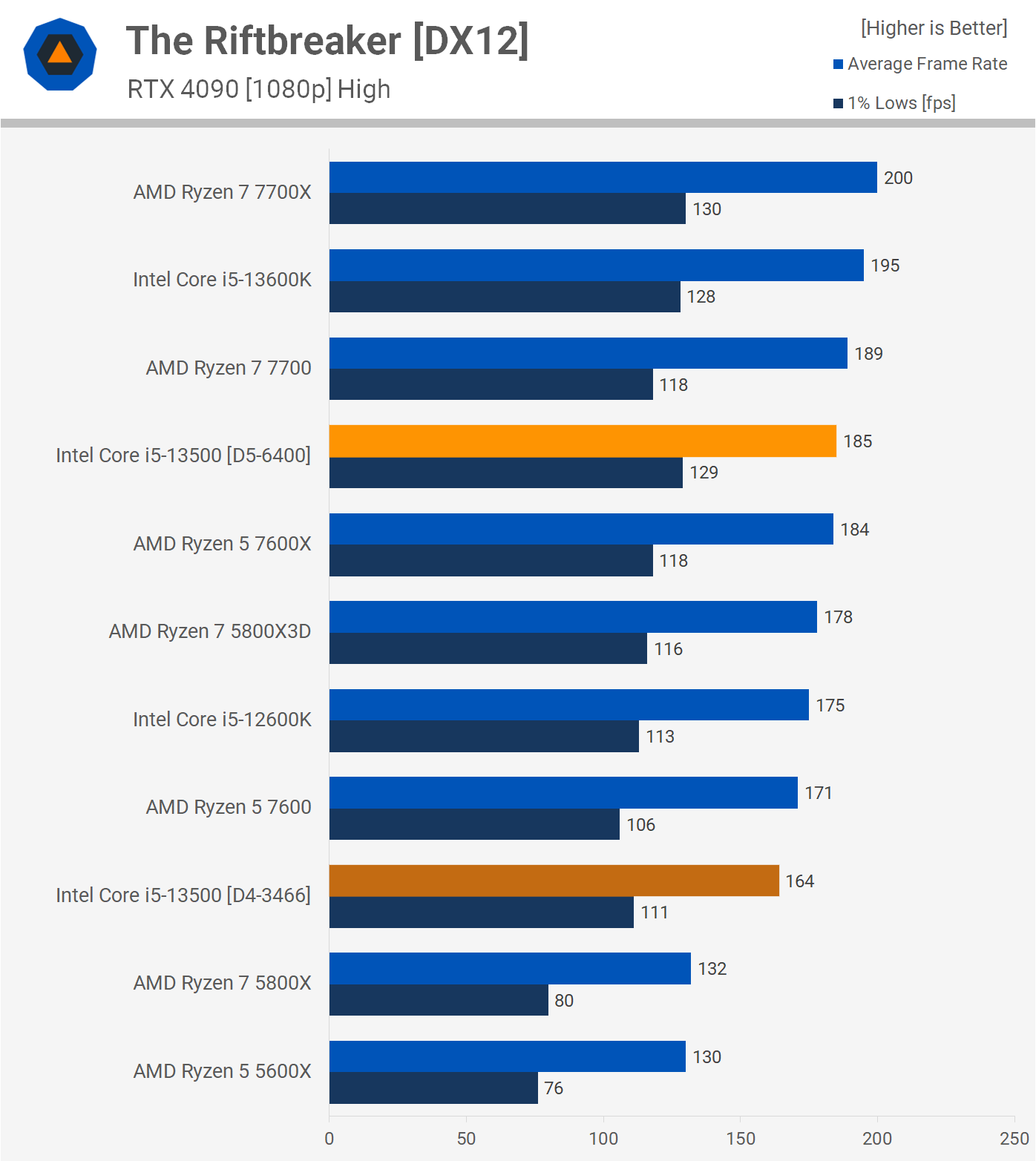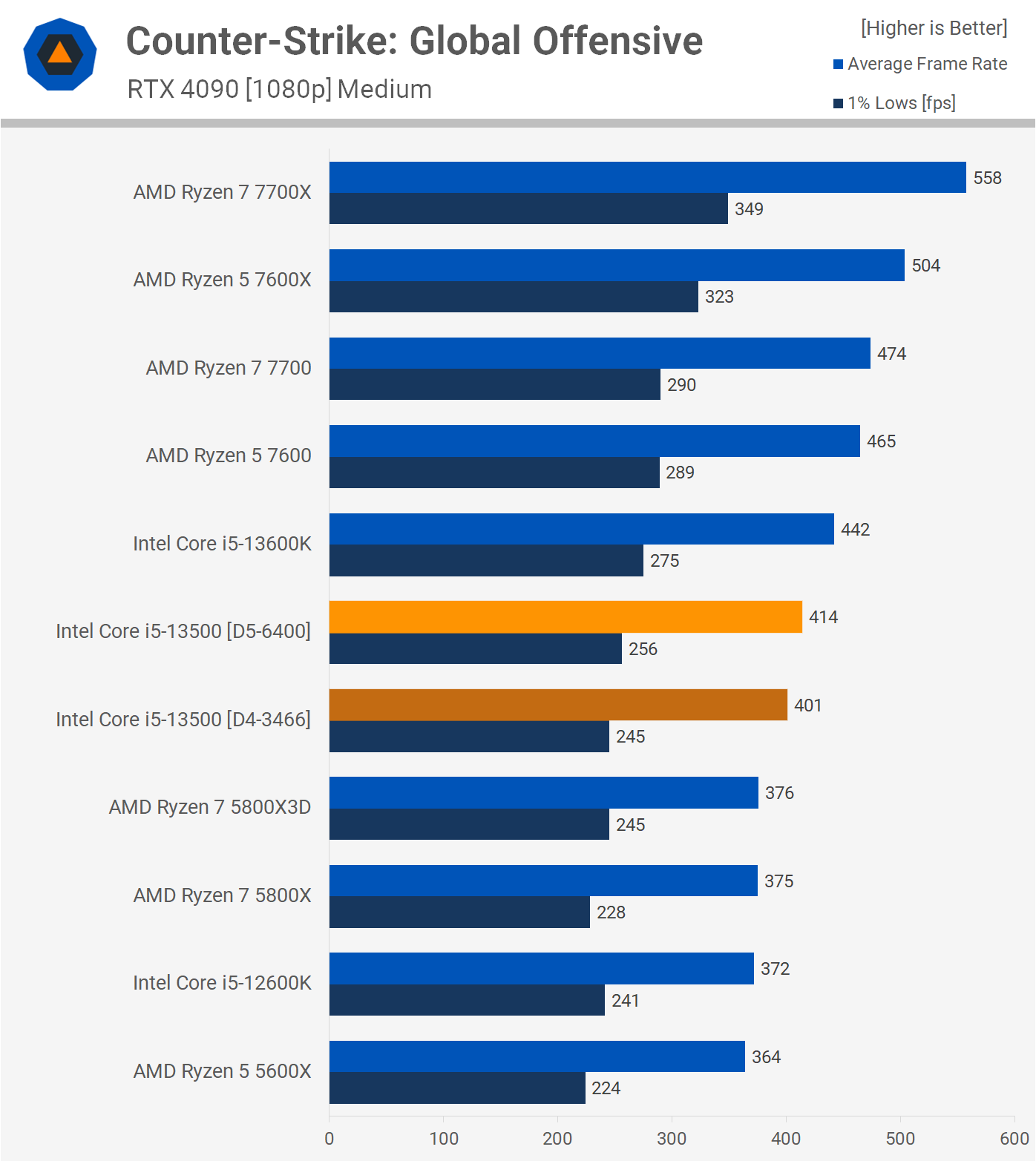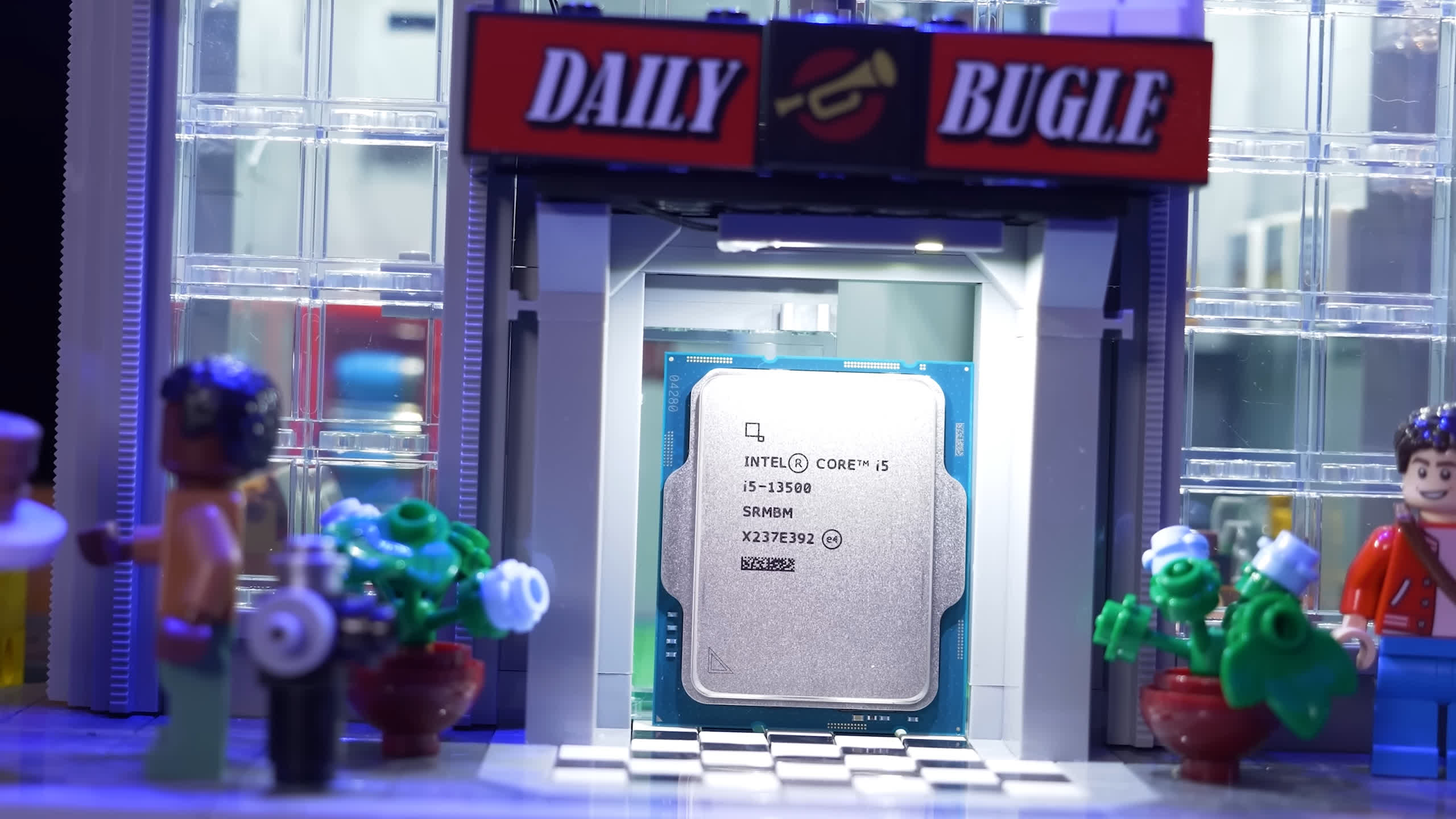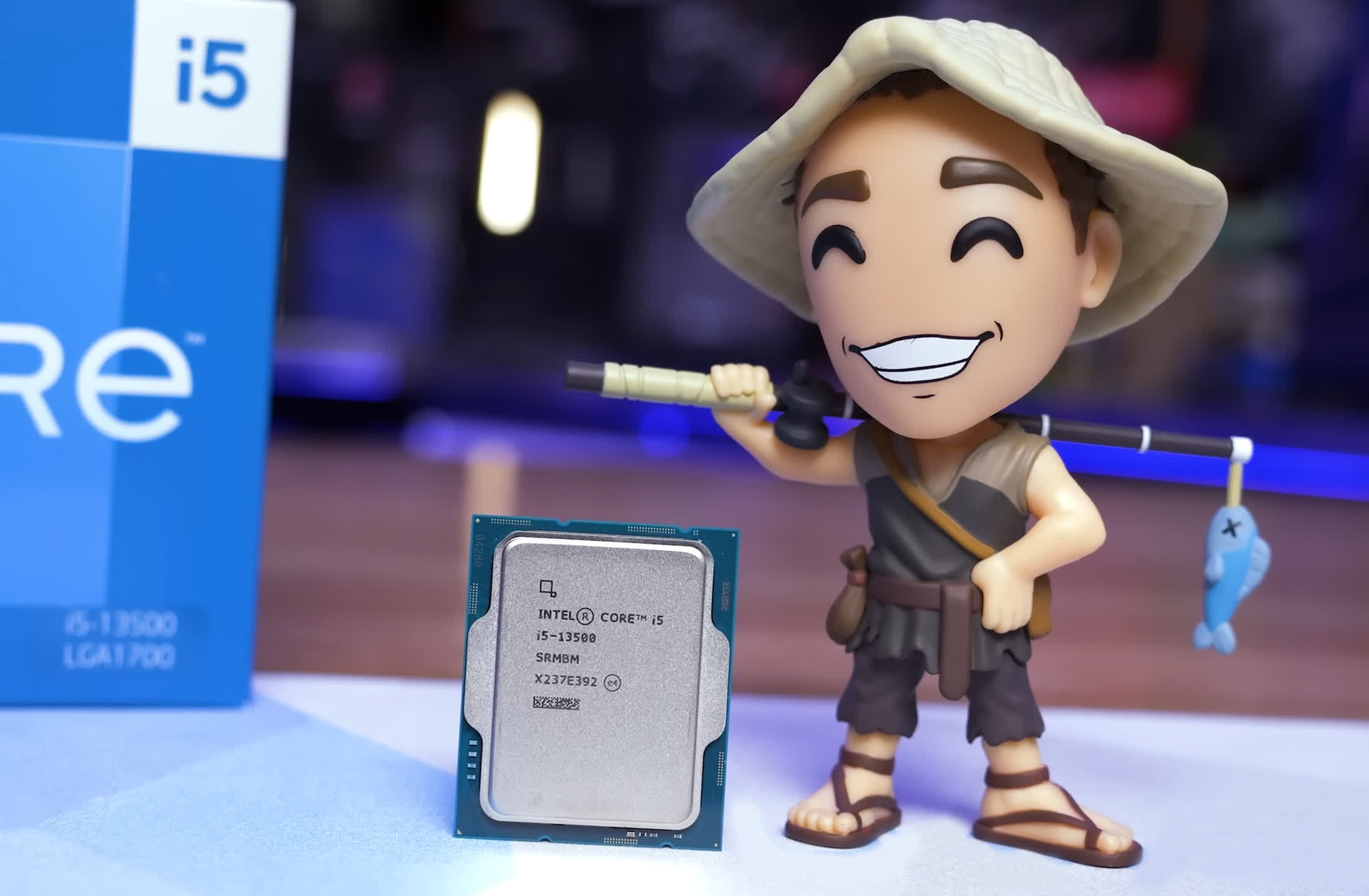The Core i5-13500 is Intel's new $250 offering, packing 14 cores in total, 20 threads and 35.5 MB cache. This is an interesting almost hybrid-like CPU as it packs the larger L3 cache capacity of the Raptor Lake i5's while using the smaller L2 cache of Alder Lake, so it's not merely a locked version of the impressive 13600K, so we're very keen to see how it performs.
The 13500 is an interesting processor. When compared to the 13600K you get the same 6 P-Cores with Hyper-Threading support for 12 threads, but where the 13600K cores clock as high as 5.1 GHz, the 13500 is capped to 4.8 GHz.
The big change is to the P-cores, where the L2 cache has been downgraded from 2 MB to 1.25 MB, which is the same capacity as Alder Lake CPUs, while the K-SKU Raptor Lake parts all received a 2 MB upgrade which does help boost performance.
The 13500 does retain all 8 E-cores, for the same core count as the 13600K and twice that of the 12600K. This is a big deal as 12th-gen locked Core i5's such as the 12500 didn't feature any E-cores at all, so we're going from zero to eight in a single generation. However, like the P-cores, the E-cores are receiving the 12th-gen cache capacity, so unlike the 13600K E-cores which pack a 4 MB cache capacity per cluster, the 13500 has been downgraded to 2 MB per cluster.
Despite these changes, the L3 cache capacity remains 24 MB, the same as the 13600K and 4 MB more than what you get with the 12600K and 6 MB more than the 12500.
At $250 the Core i5-13500 could be well positioned as the best value all rounder for budget oriented builds and its main competition here would be the Ryzen 5 7600.
The 13500 has the advantage of working on cheaper B660 boards using DDR4 memory, so we'll be looking at that along with a DDR5 configuration. For this we'll be using G.Skill Ripjaws V 32GB DDR4-3600 CL16 memory as it can currently be had for $115, it's a good quality kit that offers a nice balance of price to performance.
Please note that the locked Intel processors can't run above 3466 if you want to use the Gear 1 mode, and ideally you'd want to use Gear 1 as the memory has to run well above 4000 before Gear 2 can match Gear 1. The reason for this limitation is due to the System Agent (or SA voltage) which is locked on Non-K SKU processors, and this limits the memory controller's ability to support high frequency memory using Gear 1 mode. That being the case, we've tested the 12100 and 13100 using the Ripjaws memory adjusted to 3466, as this is the optimal configuration for these processors short of going and manually tuning the sub-timings, which we're not doing for this review.
The key competitor for the Core i5-13500 is the Ryzen 5 7600, so this will be the comparison we focus on. However, we've also included other processors for reference, but please note the data isn't always an apples to apples comparison in terms of memory configurations. The AM4 processors were tested using DDR4-3200 CL14 memory (in the past we have found this comparable to DDR4-3600 CL16), but we still wanted to point out that difference. Let's get into the data...
Clock Speeds
Here's a look at how the Core i5-13500 operates using the supplied box cooler, which we won't be using for our testing as it's not very good and you should definitely replace it when buying this processor, a cheap $20 tower style cooler will do the trick.
With the box cooler installed thermal throttling kicked in after roughly 25 seconds. Initially the 13500 P-cores ran at 4.5 GHz with the E-cores at 3.5 GHz, after an hour the P-cores were running at 4.2 GHz and the E-cores at 3.4 GHz, so a 7% reduction on the P-cores and just a 3% drop for the E-cores.
Those aren't massive performance dips but it's worth noting that the core temperature ran at 92c with a CPU package power of 100c, and this is while throttling.
So as usual we ditched the terrible box cooler for the testing, and instead used the be quiet! Pure Loop 2 FX 360mm AIO. With the liquid cooler the i5-13500 maintained a P-core frequency of 4.5 GHz and an E-core frequency of 3.5 GHz, so after an hour of load we saw no dip in the clock speeds and that's because the 13500 ran at just 62c, which is well below the thermal threshold.
Application Benchmarks
Starting with Cinebench R23 multi-core results we see that the Core i5-13500 is very impressive for core-heavy productivity workloads that can utilize the E-cores well.
When compared to the Ryzen 7600, we're looking at a 44% increase in performance, a massive gain that sees the locked Core i5 even outpacing the 7700X. It was also just 12% slower than the 13600K and that difference in this test is purely down to clock speed as cache plays a very small role here.
The single core performance is similar to the Ryzen 7600 and slightly less than the 12600K for the simple fact that the 12th-gen part clocks slightly higher. Still, when compared to the 13600K we're talking about a small 6% reduction in performance.
The 7-Zip compression results are heavily influenced by memory performance. The Core i5-13500 using an optimal DDR4 configuration is only ~10% faster than the 5600X and 16% slower than the 7600. However, when armed with DDR5 memory the 13500 is 14% faster than the 7600, though it did still trail the 13600K by a 14% margin. Still, overall very good performance for the price.
DRAM performance has almost no influence on decompression performance, so here the 13500 does well using either DDR4 or DDR5 memory, delivering comparable performance to the 5800X, making it up to 10% faster than the 7600.
The Blender Open Data results are very impressive, here the E-cores are working well and as a result we're looking at Ryzen 7 7700-like performance, making the 13500 at least 28% faster than the 7600 and just 12% slower than the 13600K.
It's a similar story in the Corona benchmark, here the Core i5-13500 is 13% slower than the 13600K, but 37% faster than the 7600, and performance was much the same using either DDR4 or DDR5 memory.
Next up we have Premiere Pro 2022, and here we see when using DDR4 memory that the 13500 is slower than the Ryzen 5800X, as well as the 7600, trailing by a 9% margin.
But when paired with DDR5 memory the locked Core i5 enjoys a massive 21% performance bump, allowing it to beat the 7600 by an 11% margin to come in just 4% slower than the 13600K.
We're also seeing solid performance gains when upgrading from DDR4 to DDR5 in Photoshop, with DDR5 providing an additional 17% performance. Even so the E-cores are virtually useless in this lightly threaded application, meaning the Ryzen 7600 is still slightly faster here.
In Adobe After Effects the Core i5-13500 managed to beat the Ryzen 7600, even when using DDR4 memory, though performance was virtually identical. Armed with DDR5 though the 13500 was 9% faster than the 7600 and just a percent slower than the 13600K.
The last productivity benchmark we have is code compilation and here the Core i5-13500 again performed very well, trailing the 13600K by a mere 3% margin or 9% when using DDR4 memory. Either configuration saw it beat the 7600 and it was 17% faster when using DDR5.
Gaming Benchmarks
Time for some gaming benchmarks and we'll start with Factorio. Here the Core i5-13500 performed much the same using either DDR4 or DDR5 memory and when using DDR5 it was just 3% slower than the Ryzen 7600 and just 5% slower than the i5-13600K. Overall a great result for the locked Core i5 part.
We're going to focus on the 1080p data but we will show you the 1440p average data as well for the 10 games we tested.
In Watch Dogs Legion, we see that the i5-13500 performed much better using DDR5 memory, delivering almost 20% greater performance. When limited to DDR4 we're looking at similar performance to the Ryzen 5800X, but with DDR5 the 13500 was able to match the 7600, making it 9% slower than the 13600K.
The Rainbow Six Extraction results are very interesting as here the 13500 appears to struggle quite a bit, though the results make sense. The E-cores are of course useless here, so when it comes to gaming performance the Core i5-13500 is going to be similar to the 12600K, it's clocked slightly lower, but it packs 20% more L3 cache.
We see that when armed with the same DDR5 memory that the 13500 is 5% faster than the 12600K, but 14% slower than the 13600K and a massive 23% slower than the 7600. The Zen 4 processors perform very well in this title, though to be fair the 1% lows for the 13600K and 7600 are comparable.
The Hitman 3 performance, while very good overall, is a bit lackluster when compared to the Ryzen 7600, which matched the 13600K, at least for the average frame rate. Again, DDR5 provided the best results, boosting the average frame rate by 13% to 205 fps, the same performance delivered by the 5800X3D, and this saw the 13500 trailing the 7600 by an 8% margin.
The Core i5-13500 managed 110 fps in Spider-Man Remastered when using DDR5 and 99 fps with DDR4 making the DDR5 configuration 11% faster.
That also meant that the 13500 was just 4% slower than the 7600 and 7% slower than the 13600K which it beat the 12600K by a 7% margin, so overall solid performance and right where we'd expect this part to land.
Here we're looking at a rather substantial 20% performance uplift for the Core i5-13500 using DDR5 opposed to DDR4, pumping out 228 fps to make it 5% slower than the Ryzen 7600 and 10% slower than the 13600K. So again where we'd expect it to be given the specs, around 7% faster than the 12600K.
Like Rainbow Six Extraction, Horizon Zero Dawn heavily favors Zen 4 CPUs, and in this instance quite heavily. DDR5 memory also doesn't help the 13500 here and although it was just 8% slower than the 13600K, that made it a massive 26% slower than the 7600.
The benefits of DDR5 memory are also apparent in Cyberpunk 2077 where the Core i5-13500 is up to 22% faster thanks to the additional bandwidth. Even so with 181 fps on average that meant it was slightly slower than the Ryzen 7600, just a 4% margin in this example.
ACC benefits more from L3 cache performance than it does DRAM performance, but even so DDR5 is offering a mild 5% jump for the 13500, which saw it come in 10% slower than the 13600K and 7% slower than the 7600.
In The Riftbreaker the 13500 outperforms the 7600, delivering 8% greater performance when armed with DDR5 memory. That also made it just 5% slower than the 13600K, a great result for Intel's new locked Core i5 processor.
Last up we have Counter-Strike: Global Offensive and this is another title where AMD Zen 4 processors perform really well. With 414 fps on average, the i5-13500 was 11% faster than the 12600K, just 6% slower than the 13600K and 11% slower than the Ryzen 7600. A good result relative to the 13600K, but a weaker than typical result compared to the mainstream Ryzen part.
10 Game Average
Across the games tested, the Core i5-13500 with DDR5 memory was on average 9% slower than the Ryzen 7600.
If we were to remove games that heavily favored the Zen 4 processors such as CSGO, Rainbow Six Extraction, and in particular Horizon Zero Dawn, these two processors would be more evenly matched. However, we've found this sample of games generally reflects what we see across massive 40-50 game benchmarks, at least within a few percent points.
The Core i5-13500 does stack up well to previous generation CPUs when using DDR4 memory, offering 7% greater performance than the Ryzen 5600X, which we estimate would make it around 12% faster than the 12400.
Also here are the 1440p results for those of you interested, also using the RTX 4090.
The Ryzen 7600 was 9% faster than the 13500 using DDR5 memory, or 16% faster when limiting the i5 to DDR4. Using DDR5 the 13500 was also 5% faster than the 12600K, but 7% slower than the 13600K.
Power Consumption
When it comes to power consumption for an all-core workload, the Core i5-13500 is relatively power efficient, pushing total system usage to 231 watts using DDR4 and 266 watts with DDR5.
That's comparable power usage to the Ryzen 7700X for similar performance, the i5-13500 was just 5% slower in this test.
Having said that, the 7700X isn't exactly an efficient product, the non-X version delivered basically the same level of performance while using considerably less power. Still, in this example, the 13500 matched the 7700 when using DDR4 memory and here we see that power usage for the entire system is just 9% higher, so not too bad.
Cost vs. Performance
Running a cost per frame analysis, for the 13500 we've got two prices, one with the $115 G.Skill DDR4-3600 CL16 kit and another using the DDR5-6400 kit. The DDR5 configuration is based on a $160 Z690 board, while the DDR4 configuration is based on a decent $130 B660 board.
The Zen 4 processors are priced with the DDR5-6000 CL30 memory they were tested with along with a $180 B650 board. We know there is one Gigabyte B650 board selling for $160, but most are around $180 and up as this increases your options to three B650 boards.
Based on those prices the Ryzen 7600 comes out to a cost of $2.53 per frame and technically with a little overclocking you can match the 7600X which would reduce the cost per frame of the non-X part to $2.43, but we're not including that data here as were focusing on out of the box performance.
When it comes to gaming performance the Core i5-13500 is a little disappointing in terms of value, with the DDR4 version coming in at a cost of $2.71 per frame or $2.77 for the DDR5 configuration, making it 9% more costly per frame when compared to the 7600.
Even if we ignore the performance data, the cost of the 13500 on a DDR5 motherboard is equal to that of the 7600, while opting for DDR4 will save you a mere $65, and will without question result in less gaming performance.
What We Learned
The Core i5-13500 is a very interesting offering and certainly the best of the locked 13th-gen CPUs we've tested so far. With its 8 E-cores, this is a genuinely strong productivity CPU, power consumption is very reasonable and thermals are easy to keep in check with a decent cooler. Gaming performance is also solid, though it needs to go DDR5 to compete with the likes of the Ryzen 5 7600.
When it comes to productivity it can edge out the Ryzen 7 7700X, though depending on the workload it's not always a great deal faster than the 7600X like what we saw in our code compilation benchmark, and it can end up slower for lightly threaded applications such as Photoshop. Overall though, the 13500 is the superior productivity CPU.
Gaming is a lot less clear cut and we think things swing the other way with the 7600 being the superior choice here, even when factoring in value. The Ryzen 7600 can also be easily overclocked to produce 7600X levels of gaming performance, and while that doesn't change things drastically, it does further advantage the Ryzen processor.
Sadly, Intel has completely locked down BCLK overclocking for 13th-gen Non-K processors, so even if you have a motherboard sporting an external clock generator, it won't be able to do anything with the 13500, which really sucks and is a big blow to this part for enthusiasts.
The Intel box cooler also sucks, it's loud and sees the i5-13500 suffer thermal throttling issues in well under a minute whereas the Wraith Stealth that comes with the Ryzen 7600 avoids any throttling and is also relatively quiet. You can also achieve the performance shown in this review with the AMD box cooler, but that's not always possible with Intel's cooler.
But in our opinion the single biggest blow to the Core i5-13500 is the LGA 1700 platform, which is now at the end of the road with no future prospects.
Meanwhile, AM5 will be supported for years to come and will support future CPU generations. Zen 5 is expected to be a radical update, so having the ability to support future processors is a massive win, and it's why we'd buy the Ryzen 7600 over the i5-13500.
Had the Intel CPU offered more value for gamers, then it would make the choice a lot harder, but the fact that you need DDR5 memory to compete with the 7600, and DDR4 doesn't help much with the value equation anyway, unless you opt for a 16GB kit, but we think at this point new system builders will want to invest in a 32GB kit. You can also purchase 16GB DDR5-4800 CL38 kits for around $80 and while that might be around twice the price of a comparable DDR4 kit, a $40 saving is peanuts once you factor in the cost of the motherboard and CPU.
For productivity we could see us investing in the Core i5-13500, though we've got to admit for just $80 more the Ryzen 7 7700 would tempt us, as performance overall is similar and you get that upgrade path. But we could just keep going, the non-K 13700 can be had for $410 or the Ryzen 9 7900 for $430, and at that point we're talking about a very different budget.
